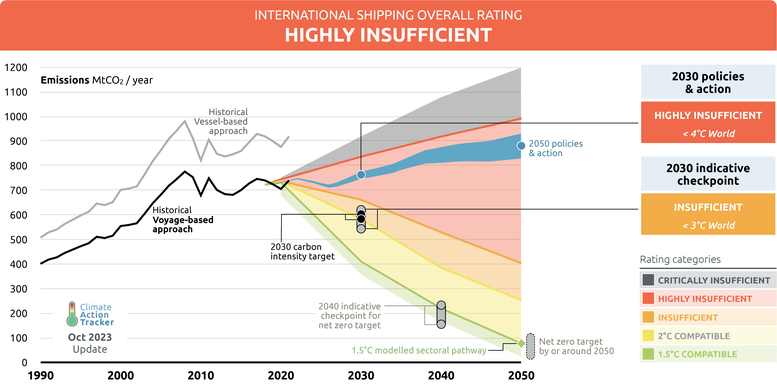IMO at a crossroads: A defining juncture for climate action and a just transition
Blog
By Michael Petroni
The International Maritime Organisation (IMO) is currently negotiating measures to help reduce emissions from the shipping industry in the medium term, as part of the 83rd session of the Marine Environment Protection Committee (MEPC83), taking place in London this week.
The most important items under discussion include a global carbon levy and a global fuel standard for international shipping. The most contentious aspects of the levy are setting the price and how to redistribute the revenues generated.
Reaching an agreement on an ambitious carbon levy, with revenues allocated to climate-vulnerable countries, would represent the best opportunity to reduce emissions from shipping while contributing to a just transition.
International shipping accounts for 3% of global emissions, roughly equal to that of Germany, a major emitting developed country. As international shipping emissions are excluded from countries’ Nationally Determined Contributions (NDCs) – the emissions reduction plans submitted under the Paris Agreement – it is crucial to reach a global agreement on ways to reduce these emissions as part of the IMO.
The Climate Action Tracker (CAT) currently rates the IMO’s overall climate ambition as “Highly Insufficient”, which means that if all countries were to follow the same level of ambition, warming would reach 4oC. This is largely because emissions from international shipping are still projected to grow under the IMO's planned policies (Read the full assessment).
We assessed the IMO’s 2023 GHG Reduction Strategy’s indicative target of reducing emissions by 20% – with an aspirational 30% target – by 2030 as “Insufficient”. This level of ambition is consistent with warming reaching 3oC. Even if the proposed measures negotiated at MEPC83 achieved the most ambitious outcome, it will still fall short of aligning with a 1.5oC compatible pathway under the Paris Agreement.

The levy and emission standard options…
The most ambitious group – the Small Island Developing States (SIDS) and Least Developed countries (LDCs) – is advocating for a global carbon levy that would introduce a flat-rate universal fee on carbon emissions, with revenues generated used not only to support maritime decarbonisation, but also to help vulnerable countries cope with the impacts of climate change.
The CAT considers that a global carbon levy is the most just and equitable option on the table. The IMO’s own Comprehensive Impact Assessment carried out by UNCTAD also found that this is the most cost-effective solution in the long term.
The European Union, once a strong supporter of the SIDS and LDCs’ proposal, has backtracked during the negotiations and is reportedly open to a compromise. The leading alternative proposal – supported by countries opposing the levy and put forward by Singapore – is called the “J9”. It proposes a credit trading mechanism and a flexible two-tiered Global Fuel Standard, as alternatives to the levy.
The issue with J9 is that it does not generate predicable or stable revenues, nor does it provide certainty for financing an equitable transition. As a result, developing countries, who are vulnerable to the high costs of fuel transitions, heavily reliant on international shipping and at a high risk of climate impacts, may lose out on the necessary financing they need.
The two-tiered approach adds further uncertainty by introducing two greenhouse gas (GHG) intensity reduction options – offering a weaker emission intensity reduction pathway. This could make LNG fuelled ships a more attractive option, thereby increasing the risks of long-term lock-in investments in fossil fuels. It also sends unclear and weak signals to the industry regarding what is needed to fully decarbonise international shipping, further jeopardising the IMO's 2030 GHG emission reduction target.
In contrast, the global levy offers multiple advantages. It is simpler to implement compared to the credit trading mechanism and can be easily adjusted and strengthened to reflect the pace of decarbonisation required.
Opposition to the more ambitious global carbon levy are led by the BRICS grouping and major oil-producing countries [1]. In an unsurprising upheaval, the US announced this week that it will withdraw from the negotiations – adding further turmoil to the situation.
Heading into the MEPC, it seemed initially that a clear majority of a 60-country coalition supported this proposal. However, with EU now wavering, the outcome has become unclear. Given that the IMO operates by consensus, the EU’s leadership is more crucial than ever in ensuring the best climate mitigation measures and the most just and equitable option remain on the table.
[1] This includes but is not limited to Australia, Argentina, Brazil, China, India, Norway, Russia, Saudi Arabia, South Africa, the UAE, and the USA.
Stay informed
Subscribe to our newsletter